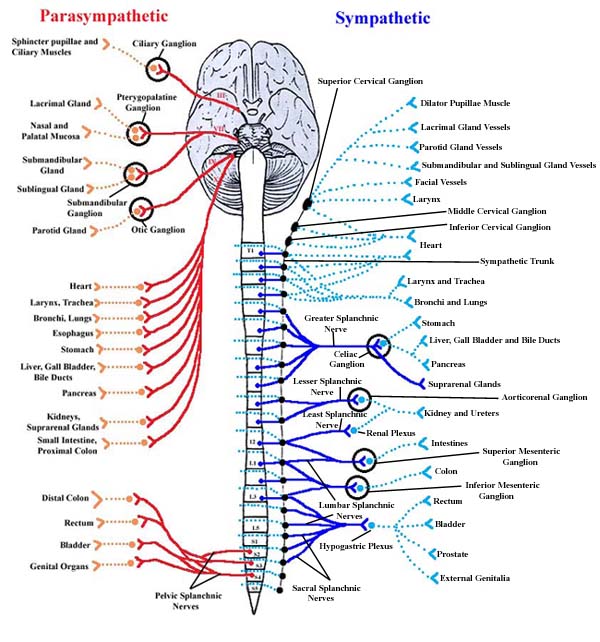
Learning Modules - Medical Gross Anatomy
Introduction to Autonomics, Part 2 - Page 12 of 12



|
Learning Modules - Medical Gross Anatomy |


|
 |
|
To review, the autonomic nervous system is divided into sympathetic and parasympathetic components. The sympathetic nervous system prepares the body for stress and is called the "fight or flight" system. The parasympathetic system prepares the body for rest and is called the "rest and digest" or "vegetative" system. Sympathetic presynaptic nerve cell bodies are located in the lateral horn of spinal cord segments T1-L2. Sympathetic postsynaptic cell bodies are in ganglia, either sympathetic chain ganglia or prevertebral ganglia. Sympathetic presynaptic fibers get to the sympathetic chain via white rami communicantes and either synapse at the level they enter, ascend or descend to synapse, or leave the sympathetic trunk without synapsing as a splanchnic nerve to go to a prevertebral ganglion. Sympathetic postsynaptic fibers may enter the spinal nerves via gray rami communicantes to be distributed with dorsal and ventral primary rami, may form perivascular plexuses to be distributed with blood vessels, or may travel to the target organ directly. The sympathetic nervous system provides sympathetic innervation to essentially every part of the body. Parasympathetic presynaptic cell bodies are located in the brainstem and the lateral horns of spinal cord segments S2, S3, and S4 and leave the CNS in cranial nerves III, VII, IX and X, and in pelvic splanchnic nerves arising from the ventral primary rami of spinal nerves S2, S3, and S4. The parasympathetic postsynaptic cell bodies are located in four pairs of ganglia in the head (associated with cranial nerves III, VII and IX), and otherwise in microscopic ganglia either on or in the wall of the target organ. The distribution of the parasympathetic nervous system is more limited than the sympathetic nervous system, with cranial nerves III, VII and IX supplying smooth muscle and glands of the head, the vagus nerve supplying the visceral organs up to the left colic flexure, and the pelvic splanchnics supplying the descending and sigmoid colon, rectum and pelvic viscera. With the exception of the external genitalia, the parasympathetic nervous system does not reach the body wall. The autonomic nervous system allows us to go about our daily business without having to think about the mechanics of our organs. Our hearts beat, our intestines digest, our blood vessels change diameter, and we adapt appropriately to any situation, all without us having to think about it. We should all stop and thank our autonomic nervous systems, for letting us concentrate on our studies in medical school. |
Go to Question |
Quit |
| Copyright© 2000 Thomas R. Gest. Unauthorized use prohibited. |